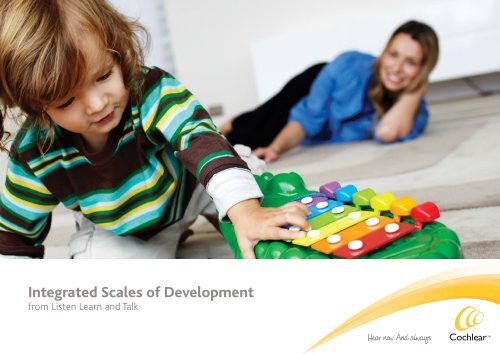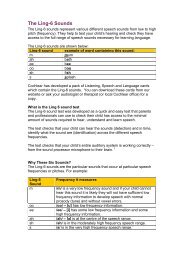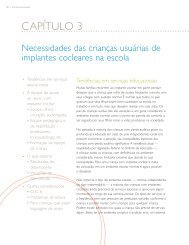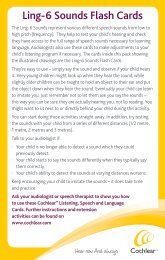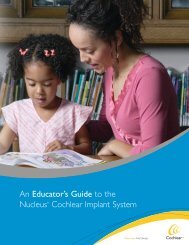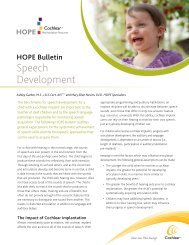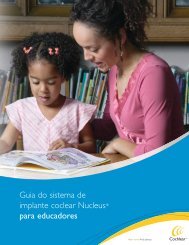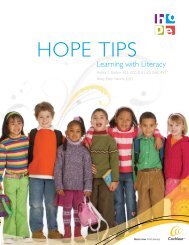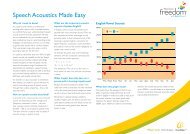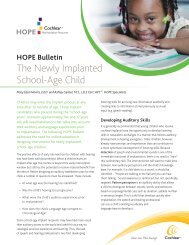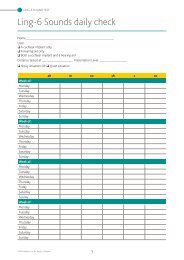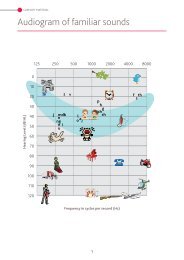Integrated Scales of Development (Listen Learn and - Cochlear
Integrated Scales of Development (Listen Learn and - Cochlear
Integrated Scales of Development (Listen Learn and - Cochlear
You also want an ePaper? Increase the reach of your titles
YUMPU automatically turns print PDFs into web optimized ePapers that Google loves.
<strong>Integrated</strong> <strong>Scales</strong> <strong>of</strong> <strong>Development</strong><br />
from <strong>Listen</strong> <strong>Learn</strong> <strong>and</strong> Talk<br />
Auditory Habilitation Theory 1
<strong>Integrated</strong> <strong>Scales</strong> <strong>of</strong> <strong>Development</strong><br />
Language enables us to comprehend <strong>and</strong> express ideas, thoughts, opinions <strong>and</strong> emotions.<br />
In the language learning process, underst<strong>and</strong>ing the language heard, that is, receptive language, always precedes the development <strong>of</strong> expressive language. A<br />
young baby will turn when her mother calls her, or wave goodbye when asked, long before she can say her own name or say bye bye. As well as learning to<br />
underst<strong>and</strong> <strong>and</strong> express language, the development <strong>of</strong> pragmatic skills is necessary in order to use language appropriately in different social contexts <strong>and</strong><br />
for different purposes.<br />
From birth to school age is a time <strong>of</strong> enormous development in a child’s life. A baby grows from a totally dependent being into a competent communicator<br />
<strong>and</strong> an independent thinker <strong>and</strong> learner by the time she begins school.<br />
The following tables are an integrated scale that outline typical stages <strong>of</strong> development in the areas <strong>of</strong> listening, receptive <strong>and</strong> expressive language, speech,<br />
cognition <strong>and</strong> social communication. They have been adapted from a number <strong>of</strong> sources:<br />
• Cottage Acquisition <strong>Scales</strong> for <strong>Listen</strong>ing, Language <strong>and</strong> Speech<br />
• Preschool Language Scale – 4 (PLS 4)<br />
• The Bzoch-League Receptive-Expressive Emergent Language Scale Second Edition<br />
• (REEL - 2)<br />
• The Early <strong>Learn</strong>ing Accomplishment Pr<strong>of</strong>ile Kit (E-LAP)<br />
• The <strong>Learn</strong>ing Accomplishment Pr<strong>of</strong>ile Revised Edition Kit (LAP-R)<br />
• The Rosetti Infant-Toddler Language Scale<br />
• St. Gabriel’s Curriculum<br />
A child with hearing impairment follows these stages <strong>of</strong> development. However, she will need greater exposure to spoken language from the earliest possible<br />
time. Language, speech, cognition <strong>and</strong> pragmatic skills should be developed concurrently through listening in a systematic program that follows the<br />
typical stages <strong>of</strong> development.<br />
It is important to remember that the skills listed on the following pages are based on an average.<br />
There is a considerable range between the earliest <strong>and</strong> latest times children achieve the various milestones. Your child may not reach a milestone within<br />
the given timeframe, but this does not mean that they will not achieve it. These developmental scales are meant as a guide only. They have been included<br />
to assist in the provision <strong>of</strong> a program to suit the individual needs <strong>of</strong> a particular child.<br />
For full reference <strong>and</strong> description see <strong>Listen</strong> <strong>Learn</strong> <strong>and</strong> Talk (Ref. Z60407). This is an auditory habilitation resource from <strong>Cochlear</strong>.<br />
Auditory Habilitation Theory 3
4<br />
Auditory Habilitation Theory<br />
0 to 3 Months<br />
<strong>Listen</strong>ing (Audition) Receptive Language Expressive Language Speech Cognition<br />
• Auditory awareness<br />
• Responds to sound by<br />
smiling, head turning,<br />
stilling, startling<br />
• Responds to loud sounds<br />
• Recognizes mother’s/<br />
caregiver’s voice<br />
• Startles to sudden noises<br />
• Responds to speaker’s face<br />
• Responds to talking by<br />
quietening or smiling<br />
• Quietens with familiar<br />
voice<br />
• Cries to express hunger<br />
<strong>and</strong> anger<br />
• Begins to vocalize to<br />
express pleasure<br />
• Occasionally vocalizes<br />
in response to voicelike<br />
sounds<br />
• Cries<br />
• Begins vocalizing other<br />
than crying, e.g. coos,<br />
gurgles<br />
• Awareness <strong>of</strong> familiar<br />
people/situations<br />
• Looks at objects/faces<br />
briefly<br />
• Anticipates certain events,<br />
e.g. being fed<br />
Social<br />
Communication<br />
(Pragmatics)<br />
• Appears to listen to<br />
speaker<br />
• Has brief eye contact but<br />
by 3 months regularly<br />
looks directly at speaker’s<br />
face, localizes speaker<br />
with eyes <strong>and</strong> starts to<br />
watch mouth rather than<br />
whole face<br />
• Smiles/coos in response,<br />
in particular to mother/<br />
caregiver
4 to 6 Months<br />
<strong>Listen</strong>ing (Audition) Receptive Language Expressive Language Speech Cognition<br />
• Sound begins to have<br />
meaning<br />
• <strong>Listen</strong>s more acutely<br />
• Starts to associate<br />
meaning to sound, e.g.<br />
responds to own name<br />
occasionally<br />
• Responds to changes in<br />
vocal inflections<br />
• Starts to localize source <strong>of</strong><br />
voice with accuracy<br />
• <strong>Listen</strong>s to own voice<br />
• Frequently localizes sound<br />
source with head or eye<br />
turn<br />
• Occasionally responds to<br />
own name<br />
• Discriminates between<br />
angry <strong>and</strong> friendly vocal<br />
tones, e.g. cries in response<br />
to an angry voice<br />
• Usually stops crying in<br />
response to voice<br />
• Vocalizes for needs <strong>and</strong><br />
wants<br />
• Vocalizes in response to<br />
singing<br />
• Blows raspberries, coos,<br />
yells<br />
• Vocalizes in response to<br />
speech<br />
• Starts to use a variety <strong>of</strong><br />
vocalizations to express<br />
pleasure <strong>and</strong> displeasure<br />
• Vocalizes when alone or<br />
with others<br />
• Laughs<br />
• Blows raspberries<br />
• Coos<br />
• Yells<br />
• Starts to change duration,<br />
pitch <strong>and</strong> intensity (prosodic<br />
features)<br />
• Uses vowel [a] as in car<br />
• Produces sounds with<br />
consonant features – friction<br />
noises, nasal [m]<br />
• Plays at making sounds<br />
• Looks at objects <strong>and</strong> reaches<br />
for them<br />
• Starts to learn about<br />
cause <strong>and</strong> effect, e.g. plays<br />
with rattle<br />
• Recognizes familiar people<br />
• Brings objects to mouth<br />
Social<br />
Communication<br />
(Pragmatics)<br />
• Maintains eye contact<br />
• Loves games such as<br />
round <strong>and</strong> round the<br />
garden<br />
• Produces different vocalizations<br />
for different<br />
reasons<br />
• Imitates facial expressions<br />
• Takes the initiative in vocalizing<br />
<strong>and</strong> engages adult<br />
in interaction<br />
• Starts to underst<strong>and</strong> vocal<br />
turn taking, e.g. vocalizes<br />
in response to adult vocal<br />
input<br />
Auditory Habilitation Theory 5
6<br />
Auditory Habilitation Theory<br />
7 to 9 Months<br />
<strong>Listen</strong>ing (Audition) Receptive Language Expressive Language Speech Cognition<br />
• Localizes sound source<br />
with accuracy<br />
• Discriminates suprasegmental<br />
aspects <strong>of</strong> duration,<br />
pitch <strong>and</strong> intensity<br />
• Has longer attention span<br />
• Associates meaning to<br />
words<br />
• Discriminates vowel <strong>and</strong><br />
syllable content<br />
• Appears to recognize<br />
names <strong>of</strong> family members<br />
in connected speech, even<br />
when person named is not<br />
in sight<br />
• Responds with appropriate<br />
arm gestures to such<br />
words as up, high, bye bye,<br />
etc.<br />
• Enjoys music or singing<br />
• Appears to listen to whole<br />
conversation between<br />
others<br />
• Regularly stops activity<br />
when name is called<br />
• Appears to recognize the<br />
names <strong>of</strong> a few common<br />
objects by localizing them<br />
when they are named<br />
• More regularly stops activity<br />
in response to “no”<br />
• Will sustain interest up<br />
to a minute while looking<br />
at pictures or books with<br />
adult<br />
• Repeats CV syllables in<br />
babble [pa pa]<br />
• Starts to respond with<br />
vocalizations when called<br />
by name<br />
• Plays more games, e.g. pat<br />
a cake, peek a boo, h<strong>and</strong><br />
clapping, etc. <strong>and</strong> vocalizes<br />
during games<br />
• Appears to “sing”<br />
• Vocalizes to greet a familiar<br />
adult<br />
• Calls to get attention<br />
• Uses some gestures <strong>and</strong><br />
language appropriately,<br />
e.g. shakes head for “ho”<br />
• Vocalizes loudly<br />
• Babbles CV CV [pa pa]<br />
[ba ba]<br />
• Clicks tongue<br />
• Uses a “singsong” voice<br />
• Imitates patterns <strong>of</strong> intonation<br />
• Uses low central vowels<br />
most frequently [o] (hot)<br />
[ae] (bat) [a] (car)<br />
• Uses some consonants [p,<br />
b, m, d]<br />
• Imitates physical action<br />
• Recognizes familiar<br />
objects<br />
• Places object in one h<strong>and</strong><br />
<strong>and</strong> then the other<br />
• Holds one cube <strong>and</strong> takes<br />
another<br />
• Smiles at self in mirror<br />
• Loves hiding <strong>and</strong> finding<br />
games<br />
• Gives, points, shows<br />
• Pulls rings <strong>of</strong>f peg<br />
Social<br />
Communication<br />
(Pragmatics)<br />
• Begins to underst<strong>and</strong> that<br />
communication is a twoway<br />
process<br />
• Shows a desire to interact<br />
with people<br />
• Becomes more lively to<br />
familiar people<br />
• Demonstrates anticipation<br />
<strong>of</strong> activities<br />
• Nods, waves <strong>and</strong> claps<br />
• Calls to get attention<br />
• Requests by reaching <strong>and</strong><br />
pointing<br />
• Enjoys frolic play<br />
• Continues to develop turn<br />
taking skills<br />
• Begins book sharing by<br />
• looking at pictures in a<br />
book with adult
10 to 12 Months<br />
<strong>Listen</strong>ing (Audition) Receptive Language Expressive Language Speech Cognition<br />
• Associates meaning to<br />
more words<br />
• Monitors own voice <strong>and</strong><br />
voices <strong>of</strong> others<br />
• Localizes sound from a<br />
distance<br />
• Discriminates speaker’s<br />
voice from competing<br />
stimuli<br />
• Appears to enjoy listening<br />
to new words<br />
• Generally able to listen<br />
to speech without being<br />
distracted by other competing<br />
sounds<br />
• Occasionally gives toys<br />
<strong>and</strong> objects to adult on<br />
verbal request<br />
• Occasionally follows<br />
simple comm<strong>and</strong>s, e.g. Put<br />
that down.<br />
• Responds to music with<br />
body or h<strong>and</strong> movement<br />
in approximate time<br />
• Demonstrates underst<strong>and</strong>ing<br />
<strong>of</strong> verbal requests<br />
with appropriate head <strong>and</strong><br />
body gestures<br />
• Shows increased attention<br />
to speech over prolonged<br />
periods <strong>of</strong> time<br />
• Uses jargon <strong>of</strong> 4 or more<br />
syllables - short sentencelike<br />
structures without<br />
true words<br />
• Starts to use varied<br />
jargon patterns with adult<br />
intonation patterns when<br />
playing alone<br />
• Initiates speech gesture<br />
games such as round <strong>and</strong><br />
round the garden<br />
• Talks to toys/objects using<br />
longer verbal patterns<br />
• Frequently responds<br />
to songs or rhymes by<br />
vocalizing<br />
• Imitates action paired<br />
with sound<br />
• May use first words, e.g.<br />
bye bye, mama<br />
• Imitates sounds <strong>and</strong><br />
• number <strong>of</strong> syllables<br />
• used by others<br />
• o Uses suprasegmental<br />
• features<br />
• o Uses longer strings <strong>of</strong><br />
• repeated syllables<br />
• o Vowels <strong>and</strong> consonants<br />
• are systematically varied<br />
• [ba di ba di]<br />
• o Mostly uses plosives<br />
• <strong>and</strong> nasals [p, b, d, m]<br />
• Resists when toy is taken<br />
away<br />
• Relates an action to an<br />
object, e.g. spoon with<br />
stirring, car with pushing<br />
• Responds to laughter by<br />
repeating action<br />
• Takes peg from peg board<br />
• Matches two identical<br />
objects<br />
• Attempts to build a two<br />
block tower<br />
Social<br />
Communication<br />
(Pragmatics)<br />
• Starts to underst<strong>and</strong><br />
question <strong>and</strong> answer, e.g.<br />
shakes head appropriately<br />
for “no”<br />
• Underst<strong>and</strong>ing <strong>of</strong> interaction<br />
continues to develop<br />
• Underst<strong>and</strong>s greetings<br />
• Turn taking skills continue<br />
to develop<br />
• Vocalizes in response to<br />
mother’s call<br />
• Indicates desire to change<br />
activities<br />
• Responds to laughter by<br />
repeating action<br />
• Begins directing others by<br />
tugging, pushing<br />
• Vocalizes with gesture to<br />
protest<br />
• Enjoys games <strong>and</strong> initiates<br />
them<br />
Auditory Habilitation Theory 7
8<br />
Auditory Habilitation Theory<br />
13 to 15 Months<br />
<strong>Listen</strong>ing (Audition) Receptive Language Expressive Language Speech Cognition<br />
• Identifies more words<br />
• Processes simple language<br />
• Auditory memory <strong>of</strong> one<br />
item at the end <strong>of</strong> a phrase/sentence<br />
• Discriminates between<br />
familiar phrases<br />
• Follows one step directions<br />
that are familiar<br />
• Underst<strong>and</strong>s more new<br />
words each week<br />
• Follows one step directions<br />
during play<br />
• Underst<strong>and</strong>s simple where<br />
questions, e.g. Where’s<br />
daddy?<br />
• Recognizes <strong>and</strong> demonstrates<br />
underst<strong>and</strong>ing <strong>of</strong><br />
many objects by pointing<br />
• Underst<strong>and</strong>s more familiar<br />
phrases<br />
• Begins to recognize names<br />
<strong>of</strong> various body parts, e.g.<br />
eyes, h<strong>and</strong>s<br />
• Enjoys rhymes<br />
• Uses 7 or more words<br />
consistently<br />
• Uses voice <strong>and</strong> gesture to<br />
obtain desired object<br />
• Continues to use jargon<br />
with more true words<br />
developing<br />
• Incorporates pausing <strong>and</strong><br />
intonation into jargon<br />
• Imitates new words spontaneously<br />
• Sings<br />
• Imitates alternated vowels<br />
• Approximates single<br />
words<br />
• Uses most vowels in vocal<br />
play<br />
• Uses more front consonants<br />
plosives [p, b, d],<br />
nasals [m, n]<br />
• Uses fricative [h]<br />
• Uses semivowel [w]<br />
• Sustains interest in<br />
desired object for two<br />
minutes <strong>and</strong> more<br />
• Places circle in shape<br />
board<br />
• Builds a tower with two<br />
cubes<br />
• Begins to make marks on<br />
paper with thick crayon<br />
• Imitates more actions, e.g.<br />
patting doll<br />
• Demonstrates functional<br />
use <strong>of</strong> objects<br />
• Removes lid <strong>of</strong> box to find<br />
hidden toy<br />
Social<br />
Communication<br />
(Pragmatics)<br />
• Continues to develop eye<br />
contact with speaker for<br />
longer periods<br />
• Takes turns as expressive<br />
language develops<br />
• Plays fetching game<br />
• Involves others by<br />
showing things, e.g. shoes/<br />
clothing during play<br />
• Begins to underst<strong>and</strong> “wh”<br />
questions
16 to 18 Months<br />
<strong>Listen</strong>ing (Audition) Receptive Language Expressive Language Speech Cognition<br />
• Discriminates between<br />
more phrases<br />
• Identifies <strong>and</strong> associates<br />
more words to related<br />
objects, e.g. toys, body<br />
parts, food, clothing<br />
• Imitates words heard<br />
• Underst<strong>and</strong>s more simple<br />
questions<br />
• Begins to underst<strong>and</strong> longer<br />
phrases with key word<br />
in middle <strong>of</strong> sentence<br />
• Develops category vocabulary<br />
• Identifies more body parts<br />
• Finds familiar object not<br />
in sight<br />
• Underst<strong>and</strong>s 50 or more<br />
words<br />
• Identifies some clothing<br />
items, toys <strong>and</strong> food<br />
• Jargon disappears<br />
• Increases vocabulary, 10<br />
or more meaningful words<br />
• Decreases use <strong>of</strong> gesture<br />
– relies on talking to<br />
communicate<br />
• Imitates words heard<br />
• Asks for more<br />
• Increases single word<br />
approximations<br />
• Most vowels present<br />
• Still mainly producing<br />
front consonants [p, b, d,<br />
m, n, h, w]<br />
• Imitates circular scribble<br />
• Places 3 to 6 pegs in<br />
pegboard<br />
• Retrieves desired toy from<br />
behind an obstacle<br />
• Picks up small objects<br />
• Turns bottle upside down<br />
to obtain toy<br />
• Points to pictures in a<br />
book <strong>and</strong> begins to turn<br />
pages<br />
• Demonstrates object<br />
permanence<br />
Social<br />
Communication<br />
(Pragmatics)<br />
• Requests object or help<br />
from adult by gesturing<br />
<strong>and</strong> vocalizing<br />
• Initiates vocal interaction<br />
• Prefers to be with familiar<br />
people<br />
• Shows caution with<br />
strangers<br />
• Imitates other children<br />
Auditory Habilitation Theory 9
10<br />
Auditory Habilitation Theory<br />
19 to 24 Months<br />
<strong>Listen</strong>ing (Audition) Receptive Language Expressive Language Speech Cognition<br />
• Auditory memory <strong>of</strong> 2<br />
items<br />
• Discriminates songs<br />
• Comprehends a variety <strong>of</strong><br />
phrases<br />
• Discriminates descriptive<br />
phrases<br />
• Follows a two step direction,<br />
e.g. Get your ball <strong>and</strong><br />
throw it.<br />
• Identifies by category<br />
• Completes two requests<br />
with one object<br />
• Chooses two familiar<br />
objects<br />
• Comprehends action<br />
phrases<br />
• Points to a range <strong>of</strong> body<br />
parts, e.g. elbow, cheek<br />
• Begins to underst<strong>and</strong><br />
personal pronouns – my,<br />
mine, you<br />
• Recognizes new words<br />
daily<br />
• Increases comprehension -<br />
decodes simple syntax<br />
• By 24 months underst<strong>and</strong>s<br />
250 - 300 words<br />
• Occasionally imitates 2 -<br />
3 word phrases<br />
• Uses new words regularly<br />
• Increases expressive<br />
vocabulary to 30 words<br />
or more<br />
• Attempts “stories” – longer<br />
utterances in jargon to<br />
get message across<br />
• Begins to use own name<br />
when talking about self<br />
• Uses possessive pronouns<br />
– mine<br />
• May ask where questions<br />
Where car?<br />
• By 24 months may use<br />
2 - 3 word phrases with<br />
nouns, some verbs <strong>and</strong><br />
some adjectives<br />
• Approximates words<br />
• Substitutes /w/ for /r/<br />
• Uses suprasegmental<br />
features<br />
• Most vowels <strong>and</strong> diphthongs<br />
present<br />
• Consonants [k, g, t, ng]<br />
emerging<br />
• Consonants [p, b, m, h, n,<br />
d] established – used in<br />
initial position in words<br />
• Consonants <strong>of</strong>ten omitted<br />
in medial <strong>and</strong> final position<br />
• Imitates symbolic play,<br />
e.g. household activities<br />
• Uses one object as symbol<br />
for another<br />
• Places triangle, circle,<br />
square in shape board<br />
• Imitates vertical strokes<br />
• Threads three beads<br />
• Begins to tear paper<br />
• Imitates ordering <strong>of</strong> nesting<br />
cups<br />
• Begins to categorize<br />
objects in play<br />
• Uses two toys together<br />
• Stacks blocks/builds tower<br />
• Completes simple pull out<br />
puzzle<br />
• Activates mechanical toy<br />
Social<br />
Communication<br />
(Pragmatics)<br />
• Begins to develop more<br />
self confidence <strong>and</strong> is<br />
happy to be with other<br />
people<br />
• Initiates pretend play<br />
• Responds to requests<br />
from adults<br />
• Practices adult-like conversation<br />
about familiar<br />
themes<br />
• Uses words to interact<br />
• Requests information, e.g.<br />
What is this?<br />
• Develops turn taking in<br />
conversation
25 to 30 Months<br />
<strong>Listen</strong>ing (Audition) Receptive Language Expressive Language Speech Cognition<br />
• Auditory memory <strong>of</strong> 2<br />
items in different linguistic<br />
contexts<br />
• <strong>Listen</strong>s to familiar songs<br />
on tape<br />
• Comprehends longer<br />
utterances<br />
• <strong>Listen</strong>s from a distance<br />
• Begins to underst<strong>and</strong><br />
complex language<br />
• Comprehends more complex<br />
action phrases<br />
• Underst<strong>and</strong>s functions,<br />
e.g. What do we use for<br />
drinking? – points to up<br />
• Begins to underst<strong>and</strong> size<br />
differences, e.g. big/little<br />
• Begins to underst<strong>and</strong> prepositions,<br />
e.g. in, on, under<br />
• Receptive vocabulary<br />
increases<br />
• Begins to underst<strong>and</strong><br />
concept <strong>of</strong> quantity, e.g.<br />
one, all<br />
• Underst<strong>and</strong>s pronouns,<br />
e.g. he, she, they, we<br />
• Uses 2 - 3 word phrases<br />
more consistently<br />
• Uses some personal pronouns,<br />
e.g. me, you<br />
• Asks for help using two<br />
or more words, e.g. wash<br />
h<strong>and</strong>s<br />
• Begins to name primary<br />
colors<br />
• Refers to self by pronoun<br />
me<br />
• Repeats 2 numbers<br />
counting<br />
• Answers “wh” questions,<br />
e.g.. What’s that?, What’s<br />
… doing?, Who?<br />
• Recites nursery rhymes<br />
<strong>and</strong> favorite songs<br />
• Underst<strong>and</strong>s <strong>and</strong> answers<br />
“can you”. Uses negation,<br />
e.g. don’t, no<br />
• Loves experimenting with<br />
prosodic features<br />
• Begins to use stress correctly<br />
• Repeats words <strong>and</strong> phrases<br />
• Consonants [f, y] emerging<br />
• Consonants, e.g. [m, p, b]<br />
used in final position<br />
• Word/phrases shortened–<br />
medial consonants <strong>of</strong>ten<br />
omitted<br />
• Tends to over pronounce<br />
words<br />
• Different pronunciation<br />
<strong>of</strong> the same word occurs<br />
frequently<br />
• Whispers<br />
• Continues symbolic play,<br />
e.g. talking on the phone<br />
• Completes actions, e.g.<br />
clap h<strong>and</strong>s <strong>and</strong> high 5s<br />
• Uses toys appropriately<br />
• Performs related activities<br />
at play<br />
• Turns one page at a time<br />
• Imitates vertical, horizontal<br />
lines <strong>and</strong> circle<br />
• Matches identical picture<br />
to picture <strong>and</strong> shape to<br />
shape<br />
• Puts two parts <strong>of</strong> a whole<br />
together<br />
• Underst<strong>and</strong>s number concept<br />
<strong>of</strong> one <strong>and</strong> two<br />
Social<br />
Communication<br />
(Pragmatics)<br />
• Enjoys talking, e.g. pretends<br />
to have a conversation<br />
on the phone<br />
• Completes actions, e.g.<br />
Give me five<br />
• Begins to develop parallel<br />
play with other children<br />
• Talks more in play<br />
• Shares toys<br />
• Asks for help using two or<br />
more words<br />
• Uses longer utterances<br />
Auditory Habilitation Theory 11
12<br />
Auditory Habilitation Theory<br />
31 to 36 Months<br />
<strong>Listen</strong>ing (Audition) Receptive Language Expressive Language Speech Cognition<br />
• Continues to exp<strong>and</strong><br />
auditory memory - 3<br />
item auditory memory<br />
with different linguistic<br />
features<br />
• Sequences 2 pieces <strong>of</strong><br />
information in order<br />
• <strong>Listen</strong>s to stories on tape<br />
• Follows 2 - 3 directions<br />
• Underst<strong>and</strong>s most common<br />
verbs<br />
• Underst<strong>and</strong>s <strong>and</strong> responds<br />
to more complex language<br />
<strong>and</strong> comm<strong>and</strong>s<br />
• Carries out 2 - 3 verbal<br />
comm<strong>and</strong>s in one sentence<br />
• Underst<strong>and</strong>s several prepositions,<br />
e.g. in, on under<br />
• Exp<strong>and</strong>s concept development<br />
• Identifies parts <strong>of</strong> an<br />
object<br />
• Underst<strong>and</strong>s time concept,<br />
e.g. today, yesterday,<br />
tomorrow<br />
• Underst<strong>and</strong>s What is missing?/Which<br />
one does not<br />
belong?<br />
• Knows gender vocabulary<br />
• Talks about what has<br />
drawn<br />
• Gives both first <strong>and</strong> last<br />
name when asked<br />
• Relates recent experiences<br />
• Converses in 3 - 4 word<br />
simple sentences<br />
• Begins using more complex<br />
language<br />
• Uses questions, e.g. who,<br />
what, where, why<br />
• Uses pronouns, e.g. he,<br />
she, they, we, you, me<br />
• Uses some plurals<br />
• Uses possessives<br />
• Uses more negatives, e.g.<br />
not, none, nobody<br />
• Begins to use <strong>and</strong>/because<br />
• Names three or more<br />
colors<br />
• Makes some substitutions<br />
[f] for [th], [w] for [r]<br />
• Medial consonants still<br />
inconsistent<br />
• Final consonants inserted<br />
more regularly<br />
• Consonants [l, r, sh, s, z,<br />
ch] emerging<br />
• Vowels <strong>and</strong> diphthongs<br />
established<br />
• Omits some unstressed<br />
parts <strong>of</strong> speech<br />
• Pronunciation becomes<br />
more correct<br />
• Whispers frequently<br />
• Shares toys <strong>and</strong> takes<br />
turns more appropriately<br />
• Develops parallel play<br />
• Begins to develop interest<br />
in writing <strong>and</strong> drawing<br />
• Begins fantasy play<br />
• Matches six color cards<br />
• Sorts <strong>and</strong> categorizes, e.g.<br />
blocks <strong>and</strong> pegs<br />
• Names object when part<br />
<strong>of</strong> it is shown in a picture<br />
• Adds two missing body<br />
parts to a drawing<br />
• Shows interest in how <strong>and</strong><br />
why things work<br />
• Completes 2 - 3 interlocking<br />
puzzle pieces<br />
• Imitates drawing a cross<br />
Social<br />
Communication<br />
(Pragmatics)<br />
• Takes turns <strong>and</strong> shares<br />
• Recites rhymes<br />
• Acts out songs - sometimes<br />
changes endings<br />
• Engages in make-believe<br />
activities<br />
• Begins to ask permission<br />
<strong>of</strong> others<br />
• Expresses feeling<br />
• Initiates conversation<br />
• Uses questions for a<br />
variety <strong>of</strong> reasons, e.g. to<br />
obtain information, to<br />
request
37 to 42 Months<br />
<strong>Listen</strong>ing (Audition) Receptive Language Expressive Language Speech Cognition<br />
• Auditory memory increases<br />
to 5 items<br />
• Sequences 3 or more<br />
pieces <strong>of</strong> information in<br />
order<br />
• Retells a short story<br />
• Follows 3 directions<br />
• Processes complex sentence<br />
structures<br />
• Tracks a 6 word sentence<br />
• Can listen to a 10 - 15<br />
minute story<br />
• Comprehends an increasing<br />
level <strong>of</strong> complex<br />
language<br />
• Underst<strong>and</strong>s more difficult<br />
concepts, e.g. quality,<br />
texture, quantity<br />
• Underst<strong>and</strong>s concept<br />
<strong>of</strong> day/night, e.g. distinguishes<br />
day from night<br />
activities<br />
• Follows directions using<br />
concepts <strong>of</strong> empty/full,<br />
same/different<br />
• Underst<strong>and</strong>s locational<br />
prepositions, e.g. next to<br />
• Begins to underst<strong>and</strong><br />
comparatives, e.g. I am<br />
taller than you.<br />
• Underst<strong>and</strong>s about 900<br />
words<br />
• Holds conversations using<br />
many correct grammatical<br />
structures (plurals, possession,<br />
pronouns, prep, adj.)<br />
• Uses “when” <strong>and</strong> “how<br />
many” questions<br />
• Uses so/because<br />
• Relays a message<br />
• Describes what objects<br />
can be used for<br />
• Starts to answer “what<br />
if?” questions<br />
• Answers What is missing?<br />
• Identifies which one does<br />
not belong <strong>and</strong> answers<br />
Why?<br />
• Attempts to answer problem-solving<br />
questions,<br />
e.g. What if?<br />
• Uses about 500 intelligible<br />
words<br />
• Uses some blends, e.g.<br />
[mp, pt, br, dr, gr, sm]<br />
• Consonants [j, v, th]<br />
emerging<br />
• Some substitutions still<br />
made, e.g. [gw] for [gr] in<br />
blends<br />
• Pronunciations <strong>of</strong> words<br />
more stable from one<br />
production to the next<br />
• Begins one-to-one correspondence<br />
• Follows directions using<br />
concepts, e.g empty, full,<br />
same, different<br />
• Develops more difficult<br />
concepts, e.g. quality,<br />
quantity, texture<br />
• Compares objects<br />
• Begins simple problem<br />
solving<br />
• Develops imagination<br />
Social<br />
Communication<br />
(Pragmatics)<br />
• Takes turns<br />
• Plays with other children<br />
more appropriately<br />
• Shows underst<strong>and</strong>ing <strong>of</strong><br />
others’ feelings/needs<br />
• Interacts through simple<br />
conversation<br />
• Initiates conversation<br />
• Enjoys role-plays<br />
Auditory Habilitation Theory 13
14<br />
Auditory Habilitation Theory<br />
43 to 48 Months<br />
<strong>Listen</strong>ing (Audition) Receptive Language Expressive Language Speech Cognition<br />
• Processes longer <strong>and</strong><br />
more complex language<br />
structures, e.g. Can you<br />
find something that lives in<br />
a tree, has feathers <strong>and</strong> a<br />
yellow crest?<br />
• Follows directions with<br />
more difficult concepts,<br />
e.g. Put the thick blue<br />
square behind the mpty<br />
jug.<br />
• Re-tells longer stories in<br />
detail - 5 or more sentences<br />
• Tracks an 8 word sentence<br />
• Continues to exp<strong>and</strong> vocabulary<br />
comprehension<br />
• Underst<strong>and</strong>s singular/<br />
plural<br />
• Underst<strong>and</strong>s difference<br />
between past/present/<br />
future<br />
• Answers final word analogies<br />
• Identifies objects missing<br />
from scene<br />
• Underst<strong>and</strong>s day/morning/<br />
afternoon/night<br />
• Makes comparisons <strong>of</strong><br />
speed/weight<br />
• Underst<strong>and</strong>s 1500 - 2000<br />
words<br />
• Uses his/her/their<br />
• More consistent use <strong>of</strong><br />
plurals – irregular <strong>and</strong><br />
regular<br />
• Talks about pictures <strong>and</strong><br />
story books<br />
• Uses more sophisticated<br />
imaginative play<br />
• Uses negatives <strong>and</strong> some<br />
modals, e.g. shouldn’t/<br />
won’t/ can’t<br />
• Uses comparisons<br />
• Makes inferences<br />
• Develops colloquial expressions<br />
• Uses How much? How?<br />
questions<br />
• Uses 800 - 1500 words<br />
• Uses more complex language<br />
structures<br />
• Spontaneous utterances<br />
are mostly grammatically<br />
correct<br />
• Reduces omissions <strong>and</strong><br />
substitutions<br />
• Most consonants established<br />
• More blends emerging in<br />
initial <strong>and</strong> final position<br />
• Rate <strong>and</strong> rhythm normal<br />
• Uses appropriate loudness<br />
level<br />
• Uses appropriate intonation<br />
• For accompanying chart,<br />
see Sounds <strong>of</strong> Speech pg<br />
43.<br />
• Draws simple objects<br />
• Underst<strong>and</strong>s time concepts,<br />
e.g. .today/ tomorrow/<br />
yesterday/ morning/<br />
afternoon/ night<br />
• Tells how many fingers<br />
<strong>and</strong> toes<br />
• Associates an object with<br />
an occupation, e.g. thermometer/doctor<br />
• Continues to develop<br />
imagination<br />
• Concentration increases<br />
• Copies simple picture line<br />
drawings<br />
• Matches patterns<br />
• Makes inferences<br />
Social<br />
Communication<br />
(Pragmatics)<br />
• Increases confidence <strong>and</strong><br />
self esteem<br />
• Requests made from<br />
others, e.g. shop/retail<br />
assistant<br />
• Uses intonation appropriately<br />
• Initiates conversation<br />
• Adapts to changes <strong>of</strong><br />
topic<br />
• Uses language for different<br />
communicative<br />
intent, e.g. obtaining<br />
information, giving information,<br />
expressing needs/<br />
feelings, bargaining
Sounds <strong>of</strong> Speech<br />
Sounds <strong>of</strong> Speech*<br />
Sounds Age Acquired (Years)<br />
vowels vowels<br />
p popcorn p<br />
m mommy m<br />
h happy h<br />
n no n<br />
w water w<br />
*<br />
b baby b<br />
k cake k<br />
g go g<br />
d daddy d<br />
1 2 3 4 5 6 7 8<br />
t tomato t<br />
ng ring ng<br />
f funny f<br />
y yellow y<br />
r rabbit r<br />
l lion l<br />
s sun s<br />
ch cheese ch<br />
sh shopping sh<br />
z zebra z<br />
j jack j<br />
v velvet v<br />
th think th<br />
TH those TH<br />
zh pleasure zh<br />
* Typical average upper age limits <strong>of</strong> consonant production<br />
* Typical average upper age limits <strong>of</strong> consonant production<br />
Acknowledgement<br />
Source: Estabrooks, W. (1998) <strong>Cochlear</strong> Implant for Kids,<br />
© 1998 Warren Estabrooks <strong>and</strong> The<br />
Alex<strong>and</strong>er Graham Bell Association <strong>of</strong> the Deaf. Inc. Reprinted<br />
by Permission.<br />
Auditory Habilitation Theory 15
16<br />
Auditory Habilitation Theory<br />
Personal Notes
Personal Notes<br />
Auditory Habilitation Theory 17
18<br />
This form is designed to be used with <strong>Integrated</strong> <strong>Scales</strong> <strong>of</strong> <strong>Development</strong> (<strong>Listen</strong> <strong>Learn</strong> <strong>and</strong> Talk - <strong>Cochlear</strong> 2005).<br />
How to use the ISD tracking form:<br />
1. Complete the child’s name <strong>and</strong> information in the space at the top <strong>of</strong> the form.<br />
2. Record the child’s progress by reference to the <strong>Integrated</strong> <strong>Scales</strong> <strong>of</strong> <strong>Development</strong><br />
3. The vertical column along the left side records the child’s hearing age (HA), ie. The child’s developmental progress from the time <strong>of</strong> first effective sound<br />
access – hearing aids fitting or cochlear implant switch-on.<br />
4. The horizontal row across the top <strong>of</strong> the form shows the six key areas <strong>of</strong> development which will be followed:<br />
- Audition or <strong>Listen</strong>ing<br />
- Receptive Language: what does the child underst<strong>and</strong><br />
- Expressive Language: what does the child say<br />
- Speech: how does the child say it<br />
- Cognition: thinking processes.<br />
- Communication: social interaction with others (Pragmatics)<br />
5. For each hearing age (HA) stage, there are two spaces.<br />
( + ) emerging skills or goals. This means that the child is starting to develop skills at this stage but has not fully achieved them yet. These are<br />
goals that the parents <strong>and</strong> therapist are working on.<br />
( √ ) achieved skills or goals. This means that the child is demonstrating the particular skills <strong>of</strong> that HA stage in their spontaneous language <strong>and</strong> interactions<br />
at home, with parents, various members <strong>of</strong> the family, <strong>and</strong> later with friends.<br />
For each <strong>of</strong> the six vertical columns. Mark the start date in ( + ) column, <strong>and</strong> later, the achieved date ( √ ) on the correct line.<br />
For a clearer visual view <strong>of</strong> the child’s developmental progress, you can also fill in the spaces with the related colors, as shown in the top row. However, the<br />
dates <strong>of</strong> start, <strong>and</strong> achievement are the key information.<br />
6. CA column<br />
For each HA stage, record the child’s CA (chronological age) in the CA column. This is important information: to be able to consistently observe the gap<br />
between the HA <strong>and</strong> CA. We expect this to reduce over time.<br />
The general expectation for a child diagnosed with a hearing impairment under the age <strong>of</strong> 12 months <strong>and</strong> following an auditory habilitation program, is that<br />
they can achieve age appropriate listening <strong>and</strong> spoken language levels by school age. …’provided they are in a stimulating language enriched environment<br />
where learning through listening is the focus.’<br />
(<strong>Listen</strong> <strong>Learn</strong> <strong>and</strong> Talk p13, Auditory Habilitation Theory).<br />
Expectations would be different for those children who have additional problems.<br />
Regular monitoring <strong>of</strong> the child’s progress is recommended. This form will give a clear overview <strong>of</strong> progress in the 6 key areas <strong>of</strong> development, relative to<br />
hearing age (HA) <strong>and</strong> chronological age (CA).<br />
Auditory Habilitation Theory<br />
<strong>Integrated</strong> <strong>Scales</strong> <strong>of</strong> <strong>Development</strong> Tracking Form
<strong>Integrated</strong> <strong>Scales</strong> <strong>of</strong> <strong>Development</strong> Tracking Form<br />
NAME: DOB: S/O:<br />
HA months CA <strong>Listen</strong>ing<br />
Receptive<br />
Language<br />
Date <strong>of</strong> Birth Switch-On Date<br />
Expressive<br />
Language<br />
Speech Cognition<br />
43 - 48 √ √ √ √ √ √<br />
+ + + + + +<br />
37 - 42 √ √ √ √ √ √<br />
+ + + + + +<br />
31 - 36 √ √ √ √ √ √<br />
+ + + + + +<br />
25 - 30 √ √ √ √ √ √<br />
+ + + + + +<br />
19 - 24 √ √ √ √ √ √<br />
+ + + + + +<br />
16 - 18 √ √ √ √ √ √<br />
+ + + + + +<br />
13 - 15 √ √ √ √ √ √<br />
+ + + + + +<br />
10 - 12 √ √ √ √ √ √<br />
+ + + + + +<br />
7 - 9 √ √ √ √ √ √<br />
+ + + + + +<br />
4 - 6 √ √ √ √ √ √<br />
+ + + + + +<br />
0 - 3 √ √ √ √ √ √<br />
+ + + + + +<br />
Social<br />
Communication<br />
Auditory Habilitation Theory 19
As the global leader in hearing solutions, <strong>Cochlear</strong> is dedicated to bringing the gift<br />
<strong>of</strong> sound to people all over the world. With our hearing solutions, <strong>Cochlear</strong> has<br />
reconnected over 180,000 people to their families, friends <strong>and</strong> communities in more<br />
than 100 countries.<br />
Along with the industry’s largest investment in research <strong>and</strong> development, we<br />
continue to partner with leading international researchers <strong>and</strong> hearing pr<strong>of</strong>essionals,<br />
ensuring that we are at the forefront in the science <strong>of</strong> hearing.<br />
For the hearing impaired receiving any one <strong>of</strong> <strong>Cochlear</strong>’s hearing solutions, our<br />
commitment is that for the rest <strong>of</strong> your life you will Hear now. And always<br />
<strong>Cochlear</strong> AG, European Headquarters<br />
Peter Merian-Weg 4<br />
CH - 4052 Basel, Switzerl<strong>and</strong><br />
Tel: +41 61 205 0404<br />
Fax: +41 61 205 0405<br />
www.cochlear.com<br />
<strong>Integrated</strong> <strong>Scales</strong> <strong>of</strong> <strong>Development</strong> from <strong>Listen</strong> <strong>Learn</strong> <strong>and</strong> Talk<br />
English - December 2009


